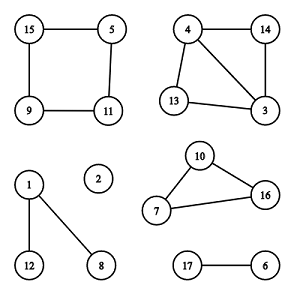E. Cyclic Components
time limit per test
2 seconds
memory limit per test
256 megabytes
input
standard input
output
standard output
You are given an undirected graph consisting of nn vertices and mm edges. Your task is to find the number of connected components which are cycles.
Here are some definitions of graph theory.
An undirected graph consists of two sets: set of nodes (called vertices) and set of edges. Each edge connects a pair of vertices. All edges are bidirectional (i.e. if a vertex aa is connected with a vertex bb, a vertex bb is also connected with a vertex aa). An edge can't connect vertex with itself, there is at most one edge between a pair of vertices.
Two vertices uu and vv belong to the same connected component if and only if there is at least one path along edges connecting uu and vv.
A connected component is a cycle if and only if its vertices can be reordered in such a way that:
- the first vertex is connected with the second vertex by an edge,
- the second vertex is connected with the third vertex by an edge,
- ...
- the last vertex is connected with the first vertex by an edge,
- all the described edges of a cycle are distinct.
A cycle doesn't contain any other edges except described above. By definition any cycle contains three or more vertices.
 There are 66 connected components, 22 of them are cycles: [7,10,16][7,10,16] and [5,11,9,15][5,11,9,15].
There are 66 connected components, 22 of them are cycles: [7,10,16][7,10,16] and [5,11,9,15][5,11,9,15].
Input
The first line contains two integer numbers nn and mm (1≤n≤2⋅1051≤n≤2⋅105, 0≤m≤2⋅1050≤m≤2⋅105) — number of vertices and edges.
The following mm lines contains edges: edge ii is given as a pair of vertices vivi, uiui (1≤vi,ui≤n1≤vi,ui≤n, ui≠viui≠vi). There is no multiple edges in the given graph, i.e. for each pair (vi,uivi,ui) there no other pairs (vi,uivi,ui) and (ui,viui,vi) in the list of edges.
Output
Print one integer — the number of connected components which are also cycles.
Examples
input
Copy
5 4
1 2
3 4
5 4
3 5
output
Copy
1
input
Copy
17 15
1 8
1 12
5 11
11 9
9 15
15 5
4 13
3 13
4 3
10 16
7 10
16 7
14 3
14 4
17 6
output
Copy
2
Note
In the first example only component [3,4,5][3,4,5] is also a cycle.
The illustration above corresponds to the second example.
/*这道题也不知道为什么,总是wa,在编译器好好地
提交上去连样例都过不了,忍不住还是想骂codeforces两句,深刻的体会到
有一个好的oj是多么的重要,我跟网上的代码对比了一下,发现没什么区别
思路还是对的,就是判断每个点的度是不是为2*/
#include <stdio.h>
#include<iostream>
#include<string.h>
#include<algorithm>
using namespace std;
int f[200005],cnt,degree[200005];
struct node
{
int u,v;
}e[200005]; //存每一条边对应的点
int find(int x)
{ //查询函数
if(x==f[x])
return f[x];
else
{
while(x!=f[x])
x=f[x];
}
}
void join(int x,int y)
{
int fx=find(x);
int fy=find(y);
if(fx==fy) cnt++; //如果两个点的根节点相同,说明有回路存在
else f[fy]=fx; //合并
}
int main()
{
int n,m,x,y,i,j,k;
while(cin>>n>>m)
{
memset(degree,0,sizeof(degree));
for(i=1;i<=n;i++)
f[i]=i;//初始化
for(i=1;i<=m;i++)
{
cin>>e[i].u>>e[i].v;
degree[e[i].u]++;
degree[e[i].v]++; //记录每个点的度
}
cnt=0;
for(i=1;i<=m;i++)
{
if(degree[e[i].u]==2 && degree[e[i].v]==2) //如果存在不是2的点,将不进行合并,这样可以破坏不符合要求的图,使它不能计数
{
x=min(e[i].u,e[i].v); //因为join函数的合并方式,所以要明确x,y大小
y=max(e[i].u,e[i].v);
join(x,y);
}
}
cout<<cnt<<endl;
}
return 0;
}过来补一下,最后还是发现自己的问题在哪里了,查询函数,没有返回值,但是dev好像可以默认返回fx,codeforces不会,下次注意了






















 762
762

 被折叠的 条评论
为什么被折叠?
被折叠的 条评论
为什么被折叠?








